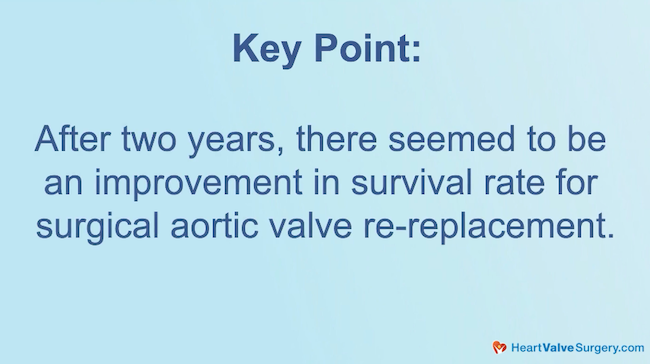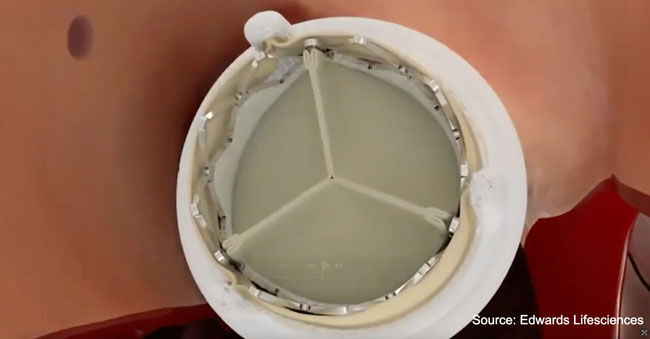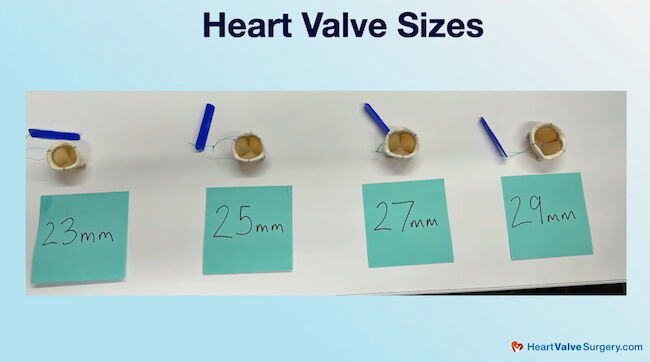SAVR vs. TAVR Re-Operation Rates: What Should Patients Know?
Written By: Allison DeMajistre, BSN, RN, CCRN
Medical Expert: Edward Soltesz, MD, Cardiac Surgeon, Cleveland Clinic, Cleveland, Ohio
Reviewed By: Adam Pick, Patient Advocate, Author & Website Founder
Published: August 11, 2025
When patients with a surgical aortic valve replacement (SAVR) find out they need a re-replacement due to degeneration of the prosthetic valve, it’s no wonder a transcatheter aortic valve replacement (TAVR) looks very attractive. SAVR is an invasive procedure that involves opening the chest, stopping the heart, and several weeks or months of recovery. Conversely, TAVR is minimally invasive; the heart isn’t stopped, and patients can often leave the day after the procedure. TAVR seems like an ideal choice.
However, over ten years of research and statistics now show that despite TAVR’s appealing qualities, SAVR may be the better option.
We received a question from Chad about SAVR versus TAVR re-operations. Chad asked, “When researching re-operative techniques, I was surprised to see a dramatic difference between TAVR valve-in-valve and traditional surgical aortic valve re-replacement, with the latter appearing much safer for the long term. I was hoping that someday, valve-in-valve would be a good option, but it’s looking like that may not be the case. Can an expert on your team explain why the hazard ratio was nearly three times with valve-in-valve?”
We met with Dr. Edward Soltesz, a leading cardiac surgeon at the Cleveland Clinic in Cleveland, Ohio, to answer Chad’s question. During his extraordinary career, Dr. Soltesz has performed over 3,000 cardiac surgeries, with more than 2,200 heart valve procedures.
New Research About SAVR Versus TAVR Re-Operations
Here are the key insights shared by Dr. Soltesz:

Dr. Edward Soltesz (Cleveland Clinic)
- The current data on SAVR versus TAVR. “Chad asks a very good question,” said Dr. Soltesz. “The issue is surrounding some of the recent data that came out looking at valve-in-valve TAVR after a previous surgical aortic valve replacement, and exactly what Chad said is true. They found a slightly higher risk of immediate complications with surgery. There was no difference in short-term mortality, but after two years, there seemed to be an improvement in survival among the re-operative surgical patients. So that begs the question as to what is going on here.” Dr. Soltesz explained that there have been several developments with the valve-in-valve TAVR and SAVR over the years.

- SAVR reoperations are shown to be an effective treatment. “About ten years ago, we realized that the re-operation risk for surgical re-operation disappeared from risk calculators,” said Dr. Soltesz. “That is to say, we’ve learned over the past 20 or 30 years how to reoperate on patients very safely by utilizing CT scans and reconstructing images of the patients’ inside to understand the topography. So, we know what to avoid and where to go, which has afforded us much lower rates of re-operative mortality.”
- Why are valve-in-valve procedures less durable? “When we talk about why a valve-in-valve is not providing durability in terms of survival beyond two years, it may be because you’re putting a valve inside another valve. Whenever you do that, there is a slight risk of patient prosthesis mismatch, and slight gradients develop, which can’t necessarily be predicted. I think the problem starts with the first valve,” said Dr. Soltesz.

- Surgeons individualize care for each patient. “I think when patients have their first valve, they must understand that we will look very closely at their risk profile as they age,” said Dr. Soltesz. “When we understand their risk profile, we can provide them with a risk estimate for reoperation and whether they should have re-operative surgery or a valve-in-valve procedure. As you can see from the data, a valve-in-valve is not always the best option. So, I think individualized care is required for patients, and we shouldn’t just offer valve-in-valve after a failed surgical valve replacement.”
- How can you and the Cleveland Clinic team find the correct valve the first time and reduce the complication of patient prosthesis mismatch? “One of the things we’ve recognized is the valve choice at the first operation or procedure is critical,” said Dr. Soltesz. “We understand that it is important to talk with the patient, have shared decision-making with them, and know that we need to implant a valve that is ideally going to last the longest for them while also providing a strategy for re-operation or re-replacement through a percutaneous means in the future by appropriately sizing the valve. Many times, we offer various types of root replacements for patients. We know from our data that minimally invasive valve surgery at the first operation confers to a lesser chance of needing blood products and a shorter ICU stay.

- Surgical expertise is the key. “We’re learning a lot about the lifetime management of aortic valve disease through the research we’ve been doing. The key is to have all the necessary surgical expertise available so that if a patient does require a root replacement or a root enlargement procedure, we have the facility to do that. We also can offer the breadth of aortic valve replacements from a Ross operation to a mechanical valve, tissue valve, and a TAVR.”
Thanks Dr. Soltesz and the Cleveland Clinic!
On behalf of all the patients in our community, thank you, Dr. Edward Soltesz, for everything you and your team are doing at the Cleveland Clinic in Cleveland, Ohio!
Related links:
- See Patient Reviews for Dr. Edward Soltesz
- Ask Dr. Soltesz: Complex and High-Risk Valve Heart Valve Surgery
Keep on tickin,
Adam
P.S. For the deaf and hard-of-hearing members of our patient community, we have provided a written transcript of our interview with Dr. Soltesz below.
Video Transcript:
Adam Pick: Hi everybody, it’s Adam with HeartValveSurgery.com and we’re in Los Angeles, California at the Society of Thoracic Surgeons Conference. I’m thrilled to be joined by Dr. Edward Soltesz, who is a leading cardiac surgeon at Cleveland Clinic in Cleveland, Ohio.
Dr. Soltesz, we’ve known each other for a long time. It is great to see you again. Nice to see you, Adam. Yeah, so we’re getting a lot of new research and data here at STS. We’re also getting questions from patients coming in from all over the world.
This question comes in from Chad about re operations for the aortic valve. Chad asks, “When researching reoperative techniques, I was surprised to see a dramatic difference between TAVR valve and valve and traditional surgical aortic valve re-replacement, with the latter appearing much safer for the long term. I was hoping that someday valve and valve would be a good option, but it’s looking like that may not be the case. Can an expert on your team explain why the hazard ratio was nearly three times with valve in valve?”
Dr. Edward Soltesz: Chad asks a very good question. The issue is surrounding some of the recent data that came out looking at valve in valve TAVR after a previous surgical aortic valve replacement.
And exactly what Chad said is true. They found that there was a slightly higher risk of immediate complications with surgery. There was no difference in short term mortality. But after two years, there seemed to be an improvement in survival among the reoperative surgical patients. So that begs the question as to what’s actually going on here.
Well, there have been a number of developments in both arms, that is the TAVR, valve and valve side, as well as the surgical side over the past number of years. Probably about 10 years ago, we realized that the re-operation, independent risk, for a surgical re-operation disappeared from risk calculators.
That is to say we’ve learned over the past 20 or 30 years how to reoperate on patients very safely, utilizing CT scans, reconstructing images of the patients inside to understand the topography. So, we know what to avoid and where to go. And that has afforded us much lower rates of reoperative mortality.
Now, when we talk about why is a valve in valve not providing durability in terms of survival beyond two years, there may be something to the effect that’s provided because you’re putting a valve inside of another valve. Whenever you do that, there is a slight risk of patient prosthesis mismatch.
And there are slight gradients that develop, which can’t necessarily be predicted. The problem, I think, starts with the first valve.
So I think patients, when they have their first valve, they have to understand very clearly that we will look very closely at their risk profile as they age to understand that risk profile and provide them with a risk estimate as to the reoperation, whether it’s a reoperative surgery or whether it’s a valve and valve.
Not always, as you can see by the data, not always is a valve and valve the best option. So, I think it’s individualized care that is required for patients. Not always, should we just be, be offering a valve in valve after a failed surgical aortic valve replacement.
Adam Pick: Dr. Soltesz, very quick follow up. I love how you brought in what I know about you is the lifetime management of valve disease. You spoke about the importance of getting the right valve the first time. And how patient prosthesis mismatch can be a complication. What are you and your team at the Cleveland Clinic doing to minimize that issue for patients?
Dr. Edward Soltesz: Good question, Adam. So one of the things we’ve recognized is the choice of valve at the first operation or procedure is critical. We are seeing that it is important to talk with the patient, have shared decision making with the patient, and understand that what we need is we need to implant a valve that is ideally going to last the longest for them, but also provide a strategy for re-operation or re-replacement through a percutaneous means in the future.
What that means is appropriately sizing the valve. Many times we offer root replacements, various different types of root replacements for patients. We know, from our data at least, that minimally invasive valve surgery at the first operation confers a lesser chance of needing blood products and a shorter ICU and a quicker return to work at a subsequent procedure in the future.
We’re learning a lot about the lifetime management of aortic valve disease through a lot of the research we’ve been doing, but the key is to have all the necessary surgical expertise available so that if a patient does require a root replacement, if a patient does require a root enlargement procedure, we have the facility to do that and we have the options to offer the breath of aortic valve replacement from a Ross operation to a mechanical valve, to a tissue valve, to a TAVR.
Adam Pick: Well, Dr. Soltesz, on behalf of Chad and all the patients HeartValveSurgery.com, patients, all over the world, thanks for everything you and your team are doing at Cleveland Clinic in Cleveland, Ohio. Thanks for being with me today.
Dr. Edward Soltesz: Thanks, Adam.





